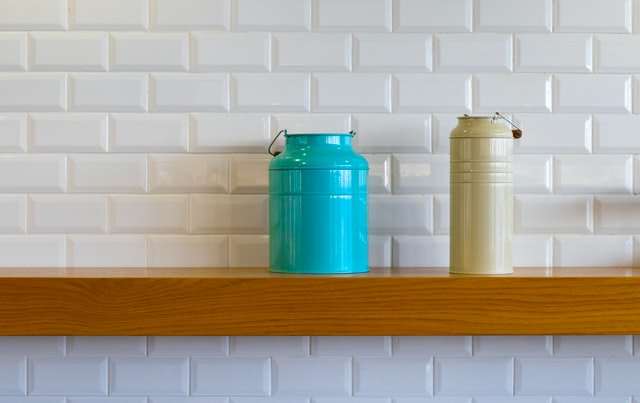When properly maintained, ceramic tile is an excellent floor covering option due to its appealing appearance, long-lasting durability, and ease of cleaning. Shape, size, colour, and texture options abound with ceramic tile. If you follow a few simple cleaning tips, you should be able to get your tile floors shining clean in no time. In the long run, regular upkeep reduces the need for large clean-ups.
Table of Contents
How To Clean Ceramic Wall Tiles In Kitchen?
Because of the texture and grout lines, debris may hide in the cracks of textured tile floors, making cleaning more difficult. A few everyday home items are all you’ll need to repair your ceramic tile.
Before You Start Scrubbing Tile Floors, Consider These Tips
Sweep the floor with a broom or vacuum cleaner before doing anything else. For the sake of the tiles, avoid using any vacuum cleaner that includes a beater bar. Thatcan bevital if you want-to keep your tile looking nice.
· Floors with Tile
Use a vinegar-and-hot-water combination to clean the floor. Ensure that the floors are thoroughly dry before going on to other cleaning procedures. When cleaning your floors, you may not even need to perform any more work if vinegar and hot water are sufficient.
· Creating a Natural Tile Cleaner
Prepare a paste by combining baking soda and water. The moderate abrasiveness of baking soda makes it an excellent all-purpose cleaner. Depending on the size of the area to be cleaned, determine how much baking soda and water you’ll need. When making a paste, it should be as thick as toothpaste.
Apply this mixture to the tile as well as grout and allow it to settle for a few minutes before wiping off the excess.In locations with thick soil, use a large amount of the product. Allow for drying time.
· Spray Vinegar on the Floors
Spray a spray bottle with 1 cup vinegar. Pure, undiluted vinegar works best. You may dilute it with hot water if you like. Vinegar may be sprayed directly onto the baking soda paste layer on the floor. Allow for a 15-minute setting time.
· Additional Steps for Cleaning
Prepare a new bucket of hot water and vinegar (1 cup).Clean the floor using a scrub brush, focusing on the dirtiest spots. If necessary, you may want to use a bit more baking soda in specific areas. However, though it requires a lot of work, it will be clean in the end.An old toothbrush may be used to clean hard-to-reach spots, such as between the grout.
After you’ve finished cleaning the floor, give it another thorough rinse with warm water. To eliminate any remaining residue and give your tile a brighter sheen, use a cloth to clean the whole surface.
· Considerations on Abrasives are critical.
It would be best if you never used a scouring pad or abrasive cleanser on a tile floor while doing tile cleaning. This is because their use might cause harm to the tile’s surface.
As a moderate, non-scratching abrasive, baking soda can go into the grooves of tiles, unlike other abrasive cleansers. If you have more tough messes to clean, you can use it if you’re attempting to avoid scouring pads and other abrasive floor cleaners.
Ceramic Tile Countertops and Backsplashes:
Sand and clay are combined to form ceramic tile, then fired at high temperatures to create a rigid, long-lasting surface. Several glazes are used on the surface to protect the region that is most easily damaged by cleaning.
- To begin, use a canister vacuum or vacuum with attachments to remove loose dust and grime. Avoid using a conventional vacuum since the bristles and beater bar will scratch and ruin the tile’s surface. Use a soft bristles attachment or brush-free vacuum for dust and dirt removal.
- Warm water should be added to two buckets. The floor will be cleaned with the first bucket and rinsed with the second. Dish soap mixed with water can be used, if the floors are particularly soiled.
- Using a mop, clean the tile floor’s surface.
- Rinse the floor with clean water from the second bucket.
- Re-clean the floor as many times as required. The buckets should be replaced on a regular interval to maintain that there will always be fresh water available.
- Wipe the wet floor with the old cloths or towels as the last step in cleaning.
- Towels can also be used to remove any lingering debris from the surface of the water.
You Will Need:
- A bucket or spray bottle
- Water (depending on the size of the area)
- Rags and worn-out clothing
- Soap for the kitchen sink (optional)
- Small scrub brush or an old toothbrush
Getting Rid of Greasy Tiles:
- To begin, use a clean, soft cloth to remove any loose debris or dust. Swiffer Dusters, for example, are excellent dust removers.
- Clean, warm water should be added to two buckets or spray bottles. Dish soap or cleanser can be added to the washing water if the countertops are very unclean.
- Use the water from the washing machine to wet the affected area.
- Scrub the tiles with a gentle cloth. • Using an old toothbrush or tiny scrub brush, scrape the grout clean.
- Clean water should be used to rinse, and clean cloth should dry.
Recommendations for Improvement
- Although some people recommend vinegar to clean unclean tiles, it is not preferred. Vinegar’s acidic characteristics can dull the surface, making it appear dirty rather than clean and sparkling when applied to a surface.
- Avoid using acid-based cleaners since these can cause the tiles to fade and become dull.
- Do not use soap to clean tiles. The soap residue on the tiles gives the impression that they are unclean.
- Fading and staining are caused by prolonged exposure to water. Spills and splashes should be quickly cleaned up.
